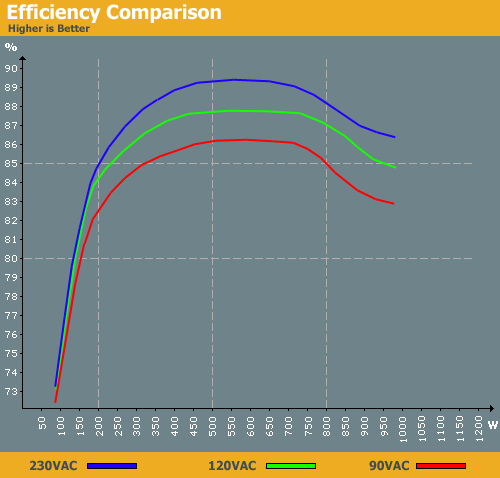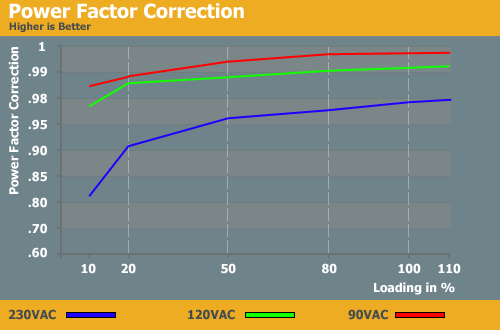Cooler Master UCP 900W
by Christoph Katzer on July 29, 2008 3:00 AM EST- Posted in
- Cases/Cooling/PSUs
Efficiency and PFC
With the 80Plus Silver badge, we expect very high efficiency results. Just to clarify, an 80Plus certification requires that a power supply reach 80% efficiency at loads from 20% to 100%. 80Plus Bronze requires at least 82% efficiency at 20% load, 85% efficiency at 50% load, and 82% efficiency at 100% load. 80Plus Silver bumps the requirements up to 85%/88%/85% for the same 20%/50%/100% loads. In short, the Cooler Master 900W UCP had better be able to reach 88% efficiency.


The results meet the 80Plus Silver requirements, actually reaching a maximum of 89% efficiency, but it's important to note that this is only possible on 230VAC. The 80Plus standard doesn't specifically state whether the efficiency should be measured on 230VAC or 115VAC, so we will have to give Cooler Master the benefit of the doubt. 115VAC users "only" get 87% efficiency. [Ed: Boohoo.] Regardless of how you look at it, this is the highest efficiency we have measured in a retail power supply to date.
Before you get too carried away with the high efficiency, however, we need to rain on your parade a bit. The 80Plus Silver badge means that most users will get at least 85% efficiency, but even 20% load represents a power output of 180W, which for an idle system represents a significant amount of high-end hardware. Optimal efficiency starts at around 350W, which pretty much means you will need a quad-core system with dual graphics cards as a reasonable minimum (and probably a bit of overclocking) in order to get full efficiency from this sort of power supply. But then you hopefully already realized this when you saw the 900W rating.

Another part of the 80Plus certification is that the power supply needs to reach at least .9 PFC, but it only needs to achieve this at 100% load. Needless to say, that's not a very difficult requirement to meet, and this PSU has a lower PFC than we have seen with most recent power supplies. PFC goes up with lower input voltages, but most power supplies easily break .99 PFC at lower loads with 115VAC. That said, the difference between .98 and .99 PFC obviously isn't very great, so this isn't something that should seriously concern potential buyers. The result could have been better, but it's not something to lose sleep over.










33 Comments
View All Comments
MrOblivious - Tuesday, July 29, 2008 - link
Sorry meant to say seems to be indicated in the article in my last line.Adamantine - Tuesday, July 29, 2008 - link
There are four 12v rails, yet you only show regulation on a single rail, not even labeled at that... where are the voltage regulation line graphs for the other 3 rails, if there are in fact 4 rails?jonnyGURU - Tuesday, July 29, 2008 - link
+12V rails are rarely independent. Usually "multiple" +12V rails is just a +12V rail split up into four, six, etc. with an over current protection circuit in place for each. If there's any "regulation" difference between one +12V rail and another, it's usually caused by resistance between the +12V source and the end of the connector and NOT actual poor voltage regulation. So the best course of action would actually be to average out the results or combine +12V rails into one.More on "multiple" +12V rails: http://forums.anandtech.com/messageview.aspx?catid...">http://forums.anandtech.com/messageview.aspx?catid...
Christoph Katzer - Tuesday, July 29, 2008 - link
ehm we combined them into one graph, that's why they are so thick ;) The graph shows in which area all of the rails have been regulated. We had shown differently before but with six rails for example you cant see anything anymore...SilthDraeth - Tuesday, July 29, 2008 - link
I read the review and I saw you nitpick about a few things, but I didn't read about any real problem.JarredWalton - Tuesday, July 29, 2008 - link
The 12V rail problem is that 12V1 (rated at 25A) supplies the power for the 24-pin connector, the 4-pin ATX12V connector, and all the SATA and Molex connectors. Meanwhile, 12V2 *only* powers the EPS12V connector (which quite a few people won't even use!), and 12V3 and 12V4 are dedicated to the PEG connectors.Basically, there's a lot of stuff coming off of the main 12V rail, and thus it's going to be virtually impossible to come anywhere near the rated output unless you happen to have an EPS12V connector on your motherboard. More important is that with the right combination of hardware (i.e. quad-core overclocked CPU, a high-end GPU, and several HDDs) you could easily overload 12V1.
strikeback03 - Wednesday, July 30, 2008 - link
The EPS12V is the 8-pin CPU connector, correct? The same one that seems to be far more common these days on the class of motherboards likely to be used with a 900W PSU than the 4-pin connector?JarredWalton - Wednesday, July 30, 2008 - link
I don't know that I would call EPS12V "common". It's used on some high-end mobos, but not on others. It was initially more of a workstation/server connector. Some PSUs have a 4/8-pin cable that works with either ATX12V or EPS12V, but it seems Cooler Master decided to go with a dedicated ATX12V and a dedicated EPS12V. It would have made a lot more sense IMO if they had all of the peripherals on the same rail as the EPS12V (and ATX12V for that matter).Bozo Galora - Tuesday, July 29, 2008 - link
Weren't you going to add ripple and noise tests?Or do I have the wrong recollection?
These guys say it had 78mv on 12V line
http://www.techpowerup.com/reviews/CoolerMaster/UC...">http://www.techpowerup.com/reviews/CoolerMaster/UC...
Amart - Tuesday, July 29, 2008 - link
Anandtech are not interested in presenting a complete professional review of PSU's, instead they have stated we should "trust them" on ripple and noise questions.I think that Anandtech PSU reviews should look at JonnyGuru.com and HardOcp.com and take notes on how to do things right.